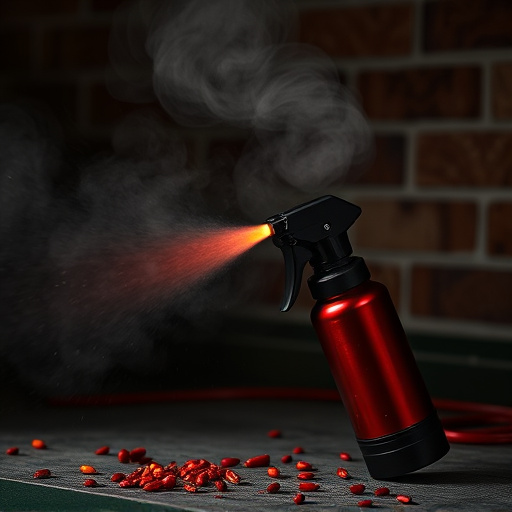Proper pepper spray storage (under 30°C/86°F, 30-50% humidity, away from sunlight) and adherence to manufacturer guidelines are key for maintaining effectiveness and optimal shelf life (2-5 years) of tactical grade pepper spray. Regular cleaning, inspection, and monitoring potency ensure dispensers remain reliable in emergency situations.
“Unleashing the power of tactical grade pepper spray requires a deep understanding of its chemical composition, effectiveness, and proper storage. This article delves into these crucial aspects, offering insights that are vital for law enforcement professionals and individuals seeking self-defense solutions. From exploring the factors influencing shelf life to providing maintenance guidelines, we ensure your pepper spray remains potent and reliable. Discover ideal storage conditions and learn how to maximize its lifespan with our comprehensive guide on pepper spray storage and shelf life.”
- Understanding Pepper Spray's Chemical Composition and Efficacy
- Factors Affecting Tactical Grade Pepper Spray Shelf Life
- Ideal Storage Conditions for Maximizing Pepper Spray Lifespan
- Regular Maintenance and Inspection Procedures for Optimal Performance
Understanding Pepper Spray's Chemical Composition and Efficacy
Pepper spray, a powerful tool for self-defense, is designed to incapacitate an assailant by temporarily blinding them and causing intense irritation and pain. Understanding its chemical composition is key to grasping its effectiveness. The primary active ingredient in most pepper sprays is capsaicin, a compound derived from chili peppers. This substance stimulates nerve endings, leading to a strong reaction in the eyes, nose, and respiratory system.
The storage and shelf life of pepper spray are essential considerations for optimal performance. Pepper spray should be stored in cool, dry places, away from direct sunlight and extreme temperatures. Proper storage ensures that the capsaicin remains potent and effective when needed. Most brands offer a clear indication of shelf life, typically ranging from 2 to 5 years, depending on usage frequency and storage conditions. Regular inspection and adherence to manufacturer guidelines are vital to guarantee its readiness when confronted with a dangerous situation.
Factors Affecting Tactical Grade Pepper Spray Shelf Life
The tactical grade pepper spray dispenser’s shelf life is influenced by several key factors, especially those related to pepper spray storage and shelf life. First and foremost, environmental conditions play a significant role. Extreme temperatures, both hot and cold, can degrade the active ingredients in pepper spray more quickly. Direct sunlight or prolonged exposure to heat sources should be avoided as they accelerate chemical breakdown. Humidity levels are another critical consideration; high humidity can lead to faster spoilage due to increased moisture absorption.
Furthermore, proper pepper spray storage involves keeping the container tightly closed and storing it in a cool, dry place, ideally below 30°C (86°F). Avoid exposing pepper spray to wet or humid environments, as this can cause corrosion and compromise its effectiveness. The way the product is handled and stored post-purchase also matters; rough handling or repeated opening of the container before use could introduce contaminants that affect shelf life. Always follow manufacturer guidelines for storage and handle tactical grade pepper spray with care to ensure optimal potency and longevity.
Ideal Storage Conditions for Maximizing Pepper Spray Lifespan
Maintaining optimal storage conditions is essential for preserving the effectiveness and lifespan of tactical grade pepper spray. To maximize its shelf life, store the dispenser in a cool, dry place, away from direct sunlight and extreme temperatures. Ideal humidity levels should be between 30-50%, with a temperature range of 10-25°C (50-77°F). Avoid storing it in damp or humid environments as moisture can compromise the integrity of the spray mechanism and reduce its potency.
Additionally, keep pepper spray out of reach of children and unauthorized individuals. Do not expose it to heat sources like ovens, radiators, or direct flame, as these conditions can cause the chemical composition to deteriorate faster. Proper storage will ensure that when you need it most, your tactical grade pepper spray is ready for action with maximum impact.
Regular Maintenance and Inspection Procedures for Optimal Performance
Regular maintenance and inspection are paramount for ensuring optimal performance from your tactical pepper spray dispenser. Users should develop a routine that includes periodic cleaning, especially after each use or in extreme conditions like high humidity. This involves wiping down the exterior with a damp cloth and carefully inspecting the spray mechanism, nozzles, and any moving parts for wear or damage. Any issues found should be addressed promptly to prevent malfunctions during critical situations.
In addition to regular cleaning, it’s crucial to check the pepper spray’s shelf life and storage conditions. Most tactical-grade pepper sprays have a specific shelf life printed on the packaging, which typically ranges from 2 to 5 years under ideal storage conditions (cool, dry places). Storing them improperly can significantly reduce their effectiveness. Always refer to manufacturer guidelines for proper Pepper Spray Storage and Shelf Life management to maintain peak performance when you need it most.
Tactical grade pepper spray is a powerful tool, but its effectiveness hinges on proper storage and shelf life management. By understanding the chemical composition, factors influencing shelf life, and ideal storage conditions, users can maximize their protection. Regular maintenance and inspections are crucial to ensure optimal performance when it matters most. Implementing these practices will extend the lifespan of your pepper spray, ensuring its readiness when needed. Remember, knowing how to store and maintain your pepper spray is just as important as understanding its tactical capabilities.
